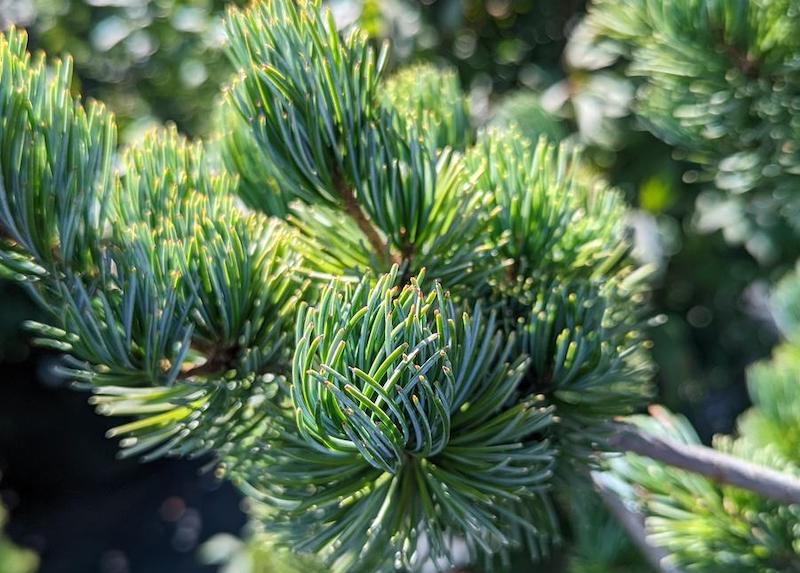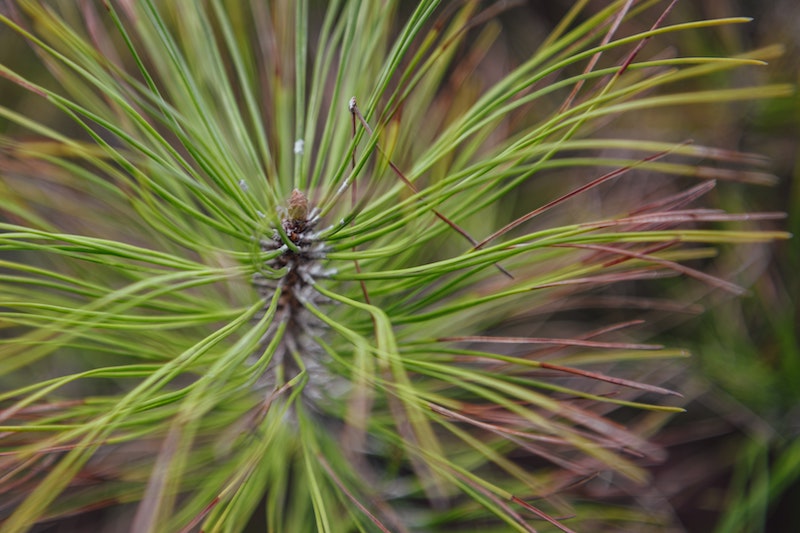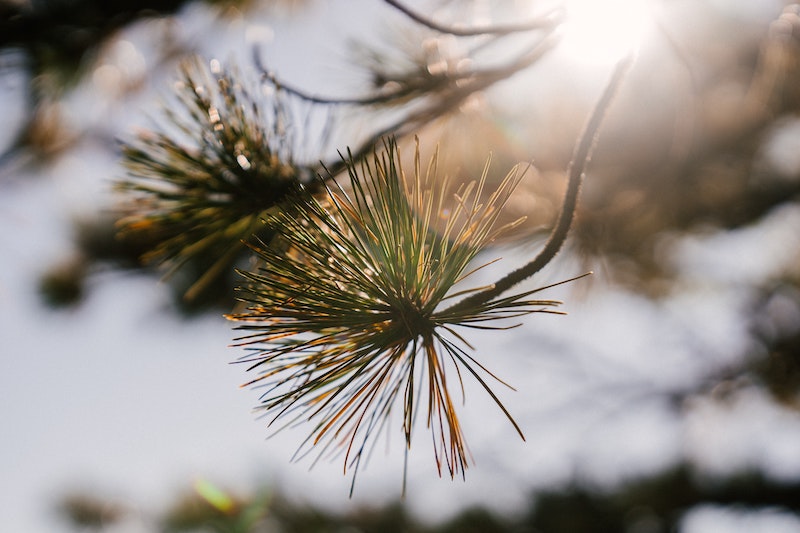Pine trees, Pinus sp., are relatively easy plants to grow. However, they may be affected by a variety of diseases, which may impact their health and longevity. Pine trees are most often infected by fungal pathogens, although some are caused by fungus-like organisms called oomycetes. The most common diseases of pine trees are needle casts, rusts, pitch canker, root rot, and tip blight. Many of the diseases that affect pine trees are species dependent, and some species of pine may be more resistant to certain diseases than others. Pine disease control for any pathogen emphasizes proper identification and prevention.

Needle Cast
Needlecasts are a group of diseases caused by numerous pathogenic fungi, such as Cyclaneusma, Ploioderma, and Lophodermium. Increased precipitation and wind in summer or fall often facilitates the spread of these diseases, as fruiting bodies from these fungi open in moist conditions. Symptoms of needle cast often mimic those of winter burn or sunscald, but symptom location and presence of fruiting bodies will indicate a fungal infection. Needle casts spread year-round whenever temperatures are above freezing. Once a tree is infected, symptoms may not appear until the following fall, winter, or spring.
Identifying Needle Cast
Pine needles will turn yellow to reddish brown, typically from the tip of the needle halfway or entirely to the base. Needles will prematurely drop from the plant. These symptoms lead to pine trees with masses of brown foliage or bare growth. Yellow to tan needles from Cyclaneusma will have brown, banded stripes. Black, oblong spots of fungal fruiting bodies may be visible on the affected needles from Lophodermium or Ploioderma. Lower branches are often affected more than higher branches.

Treating Needle Cast
Needle cast can be difficult to control once plants are infected, due to delayed symptoms and ability to spread for most of the year. Prevention is the greatest option when it comes to needle casts. When planting pine trees, provide adequate air circulation by spacing pine trees and other plants apart from one another. Prune out any branches showing signs and symptoms of needle casts, which will typically be branches lower to the ground. Use a registered fungicide per label instructions every 4-6 weeks from early spring through fall.
Rusts
Pine trees are often infected by several diverse fungal pathogens known as rusts. Needle rusts (Coleosporium), gall rusts (Endocronartium and Cronartium), and blister rusts (Cronartium) are the most common rust diseases of pine. Most rust diseases require alternative hosts to complete their life cycles. Needle rusts overwinter on plants in the Asteraceae family, namely asters and goldenrods. Pine-oak gall rusts infect oaks, Quercus sp., while pine-pine gall rusts only affect pines. Blister rusts infect currants and gooseberries, Ribes sp., in addition to eastern white pine, Pinus strobus. The spread of rust diseases is highly dependent on the pine tree’s proximity to the other host plants. Rusts spread by moist winds in spring, summer, and fall. Rust will enter the host plant if there is plenty of moisture on the leaf surface.
Identifying Rusts
All rust diseases in pine produce powdery, rust-colored spores in spring. In needle rust, small clumps of pale yellow to white spots line the needles of pine, which release the spores. Young pine trees and lower branches of more mature trees are mostly affected. Needle drop may occur, but damage to the pine is minor. Gall rusts are easily recognized by their galls, which are large, woody, rounded growths appearing on branches or trunks of two to three-needle pines. Yellow-orange spores coat the galls, giving them a rusted appearance. Needle growth is stunted and entire branches may die off under severe infections. Blister rust only affects five-needle pines such as eastern white pine. Needles will turn yellow, then orange-brown. Ovular cankers oozing sap will appear on affected branches and trunks, and entire trees may die.
Treating Rusts
Prune off any branches displaying signs of rust, such as fruiting bodies, galls, or cankers. Remove and destroy entire plants if infections are severe. Inspect all pine seedlings carefully before planting. Fungicides applied per label instructions may also be helpful. Plant pine trees away from alternative host plants, such as oaks, gooseberries, currants, goldenrods, and asters. Some hosts are more susceptible to rusts than others, such as red oak. Alternatively, rust-resistant varieties of plants such as gooseberries are commercially available. Pine needle rust in particular only affects pines aesthetically and does not require treatment unless desired, as the health of the plant is not jeopardized.
Pitch Canker
Pitch canker is a less common disease of pine trees caused by the fungus Fusarium. It is found in pines growing in the western United States, particularly along the coast and in California. This disease is often vectored by several species of beetles known to feed on pine trees. Pitch canker is favored in mild, moist climates.
Identifying Pitch Canker
Banded lesions appear on trunks, branches, and exposed roots, girdling the tissue. Resinous sap, called pitch, leaks at the site of infection. Pitch canker can interfere with the pine’s vascular system, resulting in dry, dead needles, leaf drop, branch dieback, and whole tree death. Seedlings and younger trees may die entirely if infected. The girdling from the cankers may serve as an entrance way for numerous pests, especially engraver beetles.

Treating Pitch Canker
Prune off any branches displaying symptoms of pitch canker. Where pitch canker is present, grow species of pine that are resistant to this disease. Since pitch canker is usually spread by beetles, monitor and treat pine trees for insect pests.
Root Rot
Root rot is a frequent disease of pine trees, caused by numerous fungi and oomycetes such as Verticicladiella, Phytophthora, Pythium, or Annosum, among others. Root rot affects the roots of pines, moving its way up to the crown and cambium, eventually killing the plant. This disease inhibits the uptake of water and nutrients. Root rot is present in extremely wet conditions throughout much of the year.
Identifying Root Rot
Regardless of which pathogens have caused root rot, the symptoms are mostly the same. The inner bark, or cambium, will begin to lose its green color as the rot spreads up from the roots, turning to brown. Branches will wilt and die, eventually leading to the death of the whole tree. Younger, smaller plants will die quicker than older, mature plants. Cankers and leakage of pitch are also common.
Treating Root Rot
Root rot is usually caused by wet soils with poor drainage. Prevent root rot by incorporating organic matter into the soil and avoiding soil compaction from foot traffic and machinery. Avoid planting new trees in wet locations or where previous infections of root rot were known. Remove any plants that are infected.
Tip Blight
Tip blight in pine trees is caused by the fungus Diplodia. This disease primarily affects two- or three-needle pine species, including Austrian pine, Mugo pine, red pine, and Ponderosa pine. Five-needle pines, such as eastern white pine, are resistant to tip blight. It is more likely to affect older trees.
Fruiting bodies overwinter in cones, bark, and new growth. Shoot tips are extremely susceptible to tip blight infection as they experience rapid growth in spring and early summer. Once the fungus enters the plant through wounds, stomata, or other openings, the disease spreads to the rest of the plant. Precipitation and wind help spread this disease, and poor environmental conditions, such as water stress or insect damage, can encourage it.
Identifying Tip Blight
Tip blight will affect fresh, expanding shoots before spreading to the rest of the plant. Stunted growth will be evident in these shoot tips, and their needles will not reach their full size before the tips die back. Tip blight usually appears on lower branches as it works its way up the tree, resulting in branch dieback. Resinous cankers will form at the basal end of each infected shoot. In fall, needles and cones of the pine will be dotted with black specks of fruiting bodies.
Treating Tip Blight
Prune out any infected branches. Do not over-fertilize pine trees, as this may cause increased new growth due to nitrogen. In areas with high prevalence of tip blight, grow five-needle pine species, which are resistant to this disease. Maintain optimal growing conditions to prevent increased risk of infection from stress. Apply a labeled fungicide once tip buds appear in the spring, stopping once new growth has reached its full size.
Pine Tree Disease Chart
|
Disease |
Identifying |
Treating |
|
Needle Cast |
Yellow-brown needles, leaf drop, branch dieback, brown bands or black fruiting bodies on needles |
Prune out infected branches, air circulation, apply fungicides |
|
Rusts |
Rust-colored spores, cankers and galls on branches and trunks, dieback and death |
Prune out infected branches, apply fungicides, avoid planting alternative host plants |
|
Pitch Canker |
Girdling lesions on bark, roots, branches, and trunks, resin leakage |
Prune out infected branches, monitor for insect vectors, plant resistant species |
|
Root Rot |
Wilting, dead branches and cambium, cankers oozing resin, death of tree |
Remove infected plants, aerate soil to control moisture |
|
Tip Blight |
Stunted, dead growth of shoot tips, branch dieback, black fruiting bodies on needles/cones |
Prune out infected branches, apply fungicides, avoid over-fertilizing |
 |
Lauren Youngcourt - Published 03-21-2023 |
